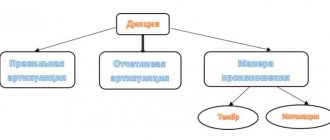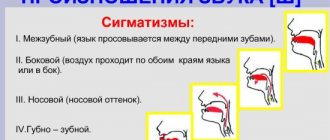The development of diction and articulation is an important part of the formation of speech culture. The child gradually masters beautiful pronunciation. The formation of the vocal apparatus and phonemic hearing ends by preschool age. However, the lack of clear pronunciation, poor articulation of phonemes and other diction deficiencies can be observed in schoolchildren and even adults. This specificity of speech is not a pathology. Diction exercises allow you to quickly cope with the problem.
Depending on the characteristics of speech development of children of different ages, speech therapists recommend various correction methods. Correcting diction will require painstaking homework, and in severe cases, a speech pathologist will be involved in establishing the correct pronunciation. Even when attending speech therapy classes (group or individual), practicing techniques and consolidating skills is carried out at home.
Stages of diction development
You can independently assess your child’s speech skills by comparing them with existing standards. However, it is worth remembering that these are average indicators. There are no exact rules.
Diction should be developed from the moment of birth. The mother sings nursery rhymes and lullabies to the baby, reads children's poems and fairy tales aloud.
From 6 to 12 months, the baby’s brain actively grows, including the formation of cells that provide speech skills. That’s why it’s so important to talk to your baby more often.
By 2-3 years, the speech structures of the brain are fully formed. By this age, the baby learns to pronounce words correctly and emotionally express thoughts and feelings. Therefore, he requires active training of the speech apparatus. But if there is no noticeable improvement in speech, there is no need to panic. It is better to visit a speech therapist and, in the absence of organic disorders, continue classes on the development of rhetoric.
Why it's time to work on your diction
Important! All pronunciation deficiencies are formed in childhood. The main cause of speech defects is improper use of the speech apparatus.
Pronunciation correction is required if the following defects are present:
- Distortion of sounds. Incorrect pronunciation of sounds: burr, lisp.
- Sound replacement. If one sound is replaced by another. For example: door-door.
- Loss of sound. Absence of sound in different parts of a word. For example: fish-fish.
Consonant sounds create the framework of speech; without them, it becomes formless and incomprehensible. It is the accuracy of the pronunciation of consonants that is the main goal in working on diction.
Enemies of beautiful speech
Beautiful speech gives a positive impression of a person and encourages further communication. It is important to correctly formulate your thoughts, change the tempo and timbre of your voice.
The main enemies of pure, beautiful speech are unnecessary words, the so-called parasites. For example: so, that means, do you understand, etc. They clog up speech, do not carry any information and complicate the understanding of the speaker’s speech.
Swear words and jargon do not create the most favorable impression of your interlocutor. A person with a good upbringing is unlikely to be familiar with such expressions.
From 0 to 12 months
The newborn attracts the mother's attention by screaming or crying. He begins to pronounce vowels by 2 months. And after 2-3 weeks, thanks to the guttural pronunciation, the mother hears “agu” or “abu”. Interaction with parents is important for the baby. He tries to repeat the sounds he heard from adults.
Experts advise infants to play children's songs, musical fairy tales, and audio books more often.
By the age of one year, a child learns to speak from 3 to 12 words consisting of one or two syllables.
From one to two years
The older the baby, the higher the clarity of pronunciation. Children actively accumulate vocabulary. They understand the meaning of the words addressed to them and fulfill the requests of mom and dad.
By the age of one and a half years, the baby usually speaks about 20 words.
This is the age of active exploration. The baby is interested in everything that surrounds him, quickly remembers new words and learns to reproduce them. Children's books with bright illustrations, which you carefully examine with your child while asking questions, help train diction.
Patter
If riddles contribute to the development of logical thinking, and sayings develop the cultural and ethical side of a child’s personality, then a tongue twister develops his diction and speech.
Tongue twister is one of the many genres of Russian folklore, presented in different forms (comic, instructive, for adults or children, etc.) and based on specific combinations of sounds that make it difficult to pronounce words.
According to V. I. Dahl's dictionary, tongue twister refers to a type of colloquial speech, which is characterized by rearrangement and repetition of identical letters/syllables that are difficult to pronounce.
Types of exercises for developing diction and clarity of speech
To achieve clear and correct sound pronunciation, many speech therapy techniques have been developed. Regular exercise promotes competent speech and good diction.
Types of exercises:
- Articulation gymnastics. It is a preparatory stage in working on diction. Low mobility of the speech apparatus does not allow children to pronounce sounds correctly. Articulatory gymnastics forces the organs to work in a coordinated manner.
- Working with breathing. Breathing training is necessary to increase the endurance of the vocal cords.
- Pronunciation of tongue twisters. This is a unique and simple material for working on speech defects. Allows you to achieve clarity of pronunciation.
- Diction tables. Designed to develop correct pronunciation of consonants in difficult combinations. They load the speech muscles, developing their activity.
How to work with tongue twisters correctly
Regular training requires not only our limbs, brain and other parts of the body, but also lips, tongue, respiratory organs - nose, larynx and lungs. The tongue is a special muscle in the human body that helps him not only cope with chewing food in the mouth, but also clearly and quickly pronounce sounds that form speech, through which people communicate with each other.
To ensure that your baby’s speech is measured and articulate, not burdened by “swallowed” and poorly pronounced sounds, teach him different tongue twisters. So, through repeated repetition of problematic sound combinations, your baby will be able to:
- develop correct pronunciation;
- learn to control your own voice;
- improve diction;
- enrich your vocabulary;
- develop memory;
- communicate his thoughts beautifully and clearly to the people around him.
What is diction and why is it important?
Diction is the correct pronunciation of sounds, corresponding to the rules of the Russian language. The intelligibility of words depends on the clarity and intensity of pronunciation of consonant sounds.
The ability to correctly pronounce verbal text is important not only for people in public professions. Good diction makes it possible to accurately convey your thoughts to other people and establish mutual understanding. After all, every pronounced sound participates in the transmission of the word, its meaning and meaning.
Severe speech impairments in a child adversely affect his mental development and behavior. An ordinary trip to the store or a conversation on the street turns into severe psychological trauma for the child. He is embarrassed by his defects, withdraws, and communication with peers fades away. The reaction of others to speech disorders (ridicule, mimicry) further aggravates the problem.
Choosing a tongue twister for a child
This process requires careful preparation, since only the material is needed that will solve the baby’s specific speech problem. For this purpose you need:
- Choose several tongue twisters with those letter combinations that the child cannot pronounce correctly and clearly.
- If your child does not understand the meaning of some words or the entire sentence, be sure to explain to him, otherwise the incomprehensible words will not be fixed in his memory and will interfere with learning.
In this case, you need to try to explain to him the meaning of the tongue twister or show it in the form of a picture:
Watch not the speed, but the accuracy of your child’s pronunciation of tongue twisters. Slow pronunciation with clear pronunciation of all letters and their combinations will contribute to better remembering the order of words in a sentence. Do not allow your child to deliberately distort the spoken words in order to make others laugh. In any activity, psychological release is important, so you can laugh a little at what funny words you get if you quickly pronounce a difficult tongue twister. However, do not forget that you have a completely different goal.
What are “training” phrases for?
Of course, in order to save a child from serious speech defects, the help of a speech therapist will be needed, but in all other cases, it is quite possible to eliminate sound errors and give him clear and intelligible speech without turning to any specialists.
The best way to acquire excellent diction and clearly pronounce words is, of course, tongue twisters (or “work twisters”), tricky phrases and sentences with a special set of words that are difficult to pronounce. Since ancient times, parents all over the world have come up with similar phrases in different languages to teach their children to speak clearly and distinctly. Almost every language in the world has its own “trainer” phrases and tongue twisters, and, of course, there are many of them in the Russian language.
There is no more effective, simple and affordable speech simulator for children and adults. It is enough to “speak quickly” and “speak hard” 10-15 minutes a day for several months to save your child from many diction problems, and teach him to pronounce the most intricate phrases and words clearly, distinctly and without hesitation.
Tongue twisters with hissing sounds
Tongue twisters with hissing sounds are the most popular tongue twisters for children using complex hissing consonants.
- Tongue twister starting with the letter Z: The bear cub was scared: Hedgehog with a hedgehog and a hedgehog, Swift with a swift and a haircut.
- Tongue twister starting with the letter C: Four turtles have four little turtles.
- Four little imps: Four little black, little little imps Drew a drawing in black ink.
- Tongue twister starting with the letter Sh: On the edge of a hut, chattering old ladies live. Every old lady has a basket, There is a cat in every basket, Cats in baskets sew boots for the old ladies.
- Sasha sewed: Sasha sewed a hat for Sashka, Sashka knocked off a bump with his hat.
- Sasha walked along the highway: Sasha walked along the highway and sucked on a dryer.
- In the hut: In the hut the yellow dervish from Algeria rustles with silks and, juggling with knives, eats figs.
- Little cuckoo in a hood: Little cuckoo bought a hood. The little cuckoo put on the hood. He looks funny in the hood!
- Tongue twister starting with the letter Ш: Two puppies, cheek to cheek, nipping a brush in the corner.
How else can you use “work talkers”
The process of composing your own tongue twisters in the form of individual phrases and quatrains can become even more exciting and useful for the development of a child. This will not only improve his diction, but also contribute to the development of important creative skills.
It is very useful to include tongue twisters in English in your child’s diction repertoire (if he, of course, studies it intensively). There are many wonderful and tricky English-language tongue twisters that will help him quickly master the oral form of the main language of international communication and speak it more confidently and clearly.
Funny tongue twisters
Simple funny tongue twisters - rhyming rhymes for young children for speech development and entertainment.
- Mouse: The mouse crawled under the lid, To gnaw the crumbs under the lid, The mouse is probably dead - The mouse forgot about the cat!
- Koschey: Skinny, weak Koschey is dragging a box of vegetables.
- Forty forty: It’s a hassle to catch a cunning magpie, And forty forty is forty hassle.
- Parrot: The parrot said to the parrot: I will parrot you, parrot. The parrot answers him: Parrot, parrot, parrot!
- Little Karas: Just a crucian gave a coloring book to the Little Karas. And the Karas said: “Color, Little Karas, a fairy tale!” On the coloring book of the Little Karas - Three funny little pigs: The Little Karas repainted the piglets into little crucians!
Complex tongue twisters
The most difficult tongue twisters for children. Well-known tongue twisters for developing diction, which you need to try to learn by heart and pronounce without hesitation.
- A tongue twister about the Chinese: Once upon a time there lived three Chinese - Yak, Yak-Tsidrak, Yak-Tsidrak-Tsidron-Tsidroni, And three more Chinese women - Tsypa, Tsypa-Dripa, Tsypa-Dripa-Lampomponi. Yak married Tsypa, Yak-Tsidrak married Tsype-Dripe, Yak-Tsidrak-Tsidron-Tsidroni on Tsype-Dripe-Lampomponi. So they had children: Yak and Tsypa - Shah, Yak-Tsidrak and Tsypa-Drypa - Shah-Sharah, Yak-Tsidrak-Tsidroni with Tsypo-Drypa-Lampoponi - Shah-Sharah-Sharoni.
- What is missing: No apricot, coconut, radish, Halibut, vinegar, kvass and rice, No compass, longboat and rope, Thermos, press, Indian sailor, No bass, no taste, weight and demand, No interest - no question.
- Feast at Kira and Fira: At Kira and Fira There was a feast in the apartment: Fakir ate marshmallows and Fakir drank kefir. And Fira and Kira did not drink kefir, did not eat marshmallows - They fed the fakir.
- Blackberries and strawberries: If you didn’t live near a blackberry tree, but if you lived near a strawberry tree, then it means strawberry jam is familiar to you and not at all familiar blackberry jam. If you lived near a blackberry tree, then it means blackberry jam is familiar to you, and not at all familiar jam strawberry. But if you lived near a blackberry tree, and if you lived near a strawberry tree, and if you didn’t spare time for the forest, then that means you ate excellent blackberry jam, strawberry jam every day.
Tongue twisters for training "r"
The sound [R] is correctly pronounced like this: the tip of the tongue is raised to the palate, and the lateral edges are pressed against the upper molars. The air passes sharply through the middle of the tongue, causing it to vibrate at the alveoli (front upper teeth). Below are tongue twisters for practicing the sound [P] in combination with other sounds:
- There is grass in the yard, there is firewood on the grass, don’t cut wood on the grass in the yard!
- They cut an ice hole and caught fish.
- A Greek was driving across the river, he saw a Greek - there was cancer in the river. He stuck the Greek’s hand into the river, and grabbed the Greek’s hand.
- Karl stole corals from Clara, and Clara stole a clarinet from Karl.
Of course, there are many pure sayings for training pronunciation and other sounds, in addition, there are complicated and specific options: liguria, shibboleth and others. You can also use even an ordinary book for speaking quickly. However, all this is beyond the scope of this article, which is aimed at introducing tongue twisters for the development of speech and diction. If you are experiencing serious difficulties pronouncing certain sounds, then you should contact a specialist who will give you the correct pronunciation. Otherwise, you risk learning incorrect pronunciation, which will then be very difficult to correct.
Diction exercises
Many parents are interested in the question: how to train good diction and have competent speech?
Working on diction involves training your voice and proper breathing. The following exercises are suitable for this:
- Stand up straight. Inhale sharply through your nose as much air as possible. Hold your breath for a few seconds and exhale just as sharply.
- Inhale, hold your breath for 3-4 seconds, exhale slowly, saying: rrrrr.
- Write down a few hard-to-pronounce words on a piece of paper, for example: expressionism, electrometallurgical, armored personnel carrier, etc. Repeat them until you learn to pronounce all the letters clearly.
- Take any short poem and read it with your mouth closed. The goal is to speak loudly and clearly so that you are heard and understood as best as possible.
Articulation apparatus training
Articulatory gymnastics must be performed daily; it is used as a warm-up before main training. Each exercise to improve diction is repeated 8-10 times. They are done in a calm environment in front of a mirror. First, perform the task at a slow pace so that the child can see the process.
- “Smile” is an exercise for developing diction and training the circular muscles of the mouth. The lips are drawn out as if for a kiss for 2 seconds. Then they break into a smile for the same time.
- “Shovel” is an activity for training speech and diction, which children really like. The tongue is relaxed, the mouth is slightly open. The tip of the tongue touches the lower lip and is held in this position for 10 seconds. It is important not to move or strain them.
- "Cupid's bow". Perfectly develops the circular muscles of the lips. Collect your lips into a tube and stretch them as far as possible. Make circular movements with your lips clockwise, then counterclockwise.
- "Horse". Stretches the hyoid fold of the tongue. The tip of the tongue is sucked to the upper palate. The clicking is done at first at a slow pace, then faster. Performed 15-20 times.
- "Snake". Trains the lateral muscles of the tongue, stretches the frenulum under the tongue. The mouth is wide open. The tongue protrudes forward, stretches out and becomes narrow. Then it quickly hides back into its mouth. Performed at an average pace 5-6 times.
Breathing training
Diction training with the help of breathing exercises helps in the correct production of sound and voice, strengthens its strength and expands its range. Good speaking technique is impossible without proper breathing, so all exercises are aimed at working the diaphragm:
- “Blow out the candle.” You will need a strip of paper. Bring it to your mouth at a distance of 5 cm. Pull out your lips, as if blowing out a candle. Start blowing slowly on the strip so that it is in the same position. It should not rise or fall. Imagine that you put a candle flame and hold it in that position. Exhalation is not interrupted.
- Tilts. An exercise to develop diction, train the breathing rhythm when moving. Standing, feet shoulder-width apart, keep your hands on your belt. Slowly tilt your body forward, inhale through your nose, and gradually return to the starting position while exhaling.
- Exercises to train chest breathing. Stand up, relax your upper torso. Take a slight breath in through your nose, as if smelling a flower, then exhale smoothly with the sound: pfffff.
- "10 candles" This activity helps train the diaphragmatic muscles. Imagine that there are 3 candles in front of you. Try to blow them out with one exhalation, without taking in air. Then 5, 7, 10 candles. There is no need to draw in a lot of air, the volume should be the same as when blowing out three candles, but it must be divided into several portions.
Tongue twisters for the development of diction
How to develop good diction quickly and without much effort? The most accessible way is tongue twisters. First, say it slowly and silently, using only your lips. Then repeat, pronouncing each sound clearly. If you can pronounce all the sounds at a calm pace, you can increase the speed.
Tongue twisters for practicing various sounds:
- Sound "Zh". The beetle flew, buzzed, buzzed, the Beetle ran, buzzed, buzzed, the beetle sat on a branch and said: B-buzz. I'm so tired of buzzing!
- Sound "K". The cuckoo crowed to the cuckoo all day, and the cuckoo said to the cuckoo: What beautiful words in the song! And she croaked loudly: “Kwa!” Kwa-kwa-kwa!
- Sound "Sh". Shura sewed a hat and pants for the bear, Shura sewed a cute sarafan for the bunny. Shura is in a hurry to sew a scarf, It is made of silk, the silk rustles.
- Sound "B". If only mushrooms had not grown in the forest, the squirrels would have had trouble in the winter - Everyone would have been left without food. It is necessary to practice diction using tongue twisters every day for 15-20 minutes.
Examples of quatrains for training
Poems are not only capable of developing memory in children, but are powerful exercises for the development of diction.
- Be-e-e, listen to the lamb's mother, the lamb's brother says, if you beat your thumbs like a slacker, you will be beaten.
- Eat, Elena, have fun, eat and don’t skimp on the porridge. If you don’t eat, Lena, you’ll definitely get sick.
- Rain, rain, no rain, rain, rain, wait: the grandfather is going home, the granddaughter is waiting for the grandfather at home.
- Petya is very friendly with the pony, and Petya serves the pony faithfully. Petya will pet the pony - the pony will give Petya a ride.
Repeated repetition of text words trains diction and develops speech muscles. When reading poetry, you should pronounce sounds clearly and expressively, and monitor your breathing and intonation.
To practice sounds B and P
Exercises to correct pronunciation deficiencies should begin with correct articulation. Say the sound in front of the mirror, pay attention to the accuracy of the articulatory pattern. First, pronounce the sounds individually, then introduce them into the speech stream.
- Diction table. Conducted daily, starting with articulation gymnastics. Difficult to pronounce combinations allow you to load all the facial muscles and develop their mobility. The phrases are repeated many times: PTKU-PTKO-PTKE-PTKE-PTKA; KTPTUP-KTPTOP-KTPTAP; BDGO-BDGU-BDGI-BDGY-BDGE; GBDUPT-GBDOPT-GBDEPT. When the child learns to clearly pronounce sounds, you can move on to more complex combinations: PTKU-BDGU, PRESH-PES, PRE-PO-BEST, BRUSH-PAS, BRISH-BIS, BDGY-BA-DATS.
- Tongue twisters: From the clatter of hooves, dust flies across the field; Killed a beaver, but didn't get the beaver.
- "Cork". For clear pronunciation of the sounds P, B, good development of the lip muscles is necessary. This exercise is well suited for training them: the lips are tightly closed, the edges are taut. Using a stream of air in the mouth, sharply break through the bow. As if you are pushing out a cork with pursed lips.
Important! Do not relax your lip muscles, they should open under the air pressure!
For clear pronunciation of V and F
Articulation: The upper lip is raised, the lower lip is extended and pressed against the upper teeth, which are visible. When pronouncing, a stream of air is exhaled between the upper teeth and lower lip. For sound B, a voice is added.
- "Hedgehog". The child should imitate the snorting of a hedgehog. Taking a deep breath and pressing your bottom lip to your teeth.
- Chains of syllables. At the beginning of the lesson, the baby pronounces the same chain of syllables: va-va-va, fu-fu-fu. Then more complex ones: wa-woo-wee, fa-fu-fi.
- "Breeze". The baby bites his lower lip with his upper incisors and blows it out of his mouth with a stream of air.
For correct pronunciation of G, K and X
Articulation: Lips and teeth are not closed. The tongue is arched, with its back pressed to the palate. When pronouncing sounds, a stream of air escapes between the palate and the tongue.
- Ask your child to say the syllables: ta-ta-ta. At this time, use a teaspoon to lower the tip of your tongue and move it slightly deeper into your mouth. The child will make a new sound: tya-ka-kya. After several lessons, the spoon is removed and the baby reproduces the sound K independently. Similar exercises are carried out on G, only the child says: yes-yes-yes, if the sound X is corrected, repeat: sa-sa-sa.
- Say alternately: K-g, k-g, k-g, k-g, k-g.
- Read each time, increase the pace: Kat-ket-kit-kai-kay-cube-kish; Hat-hat-hid-hor-hys-khas; Gus-gus-ger-gus-gas-hum.
- To consolidate the results, use tongue twisters: I praise Halva! I praise Halva!; The chicken is pecking at the kibble, smoking a Turkish pipe; The capercaillie is deaf, but not stupid.
For sounds L and M
- To correct a defect in the pronunciation of the sound L, you can use the following method: Hold the tip of your tongue with your teeth and stretch out: ыыыыы. In this position of the speech organs, the sound L is produced.
- The formation of the sound L should involve not the lips, but the tongue. To form correct articulation, the following exercise is suitable: Hold the corners of your mouth with your fingers so that they do not move, pronounce the sound, concentrating on the work of the tongue.
- "Hard-soft." A beautiful exercise for good diction and speech. Read the first syllable firmly, the second softly: WE-MI; MA-MYA; MU-MU; ME-ME; MO-ME
- "Who's on M?" Read the story to your child, then ask him to name all the words starting with the letter M that appear in the text. Masha has crayons. Masha draws a bear, a jellyfish, a poppy, and a ball. Masha showed the drawings to her mother. Mom said: Well done, Masha!
For sounds Ch and Sh
- The training of hissing words should begin with words where they occur at the beginning: scarf-fur coat-hat-noise; sharpie-rustle-mine-tent; tire-chic-awil-screen.
- Word combinations rich in necessary sounds: The rustle of mice, the rustle of leaves; Large wide brimmed hat.
- Pronouncing forward-backward syllables: CHA-ACH, CHI-ICH, CHU-UCH, CHE-ECH.
- Reading quatrains: What kind of dance is Shuttle? Heel on heel, and then tap dance - fun and clear!
Many children have difficulty with certain sounds. It’s not at all difficult to help them, you just need to do training exercises regularly. For better speech development, talk to your children and encourage them when they don’t succeed at something right away.
Exercises to warm up your tongue:
“Horse” - you need to touch your tongue to the upper palate and then sharply lower your tongue with a clicking sound;
“Spatula” - open your mouth, stick out your tongue, reach your chin.
“Candy” - you need to rest your tongue on each cheek in turn. Mouth closed.
“Pendulum” - you need to stick out your tongue. Stretch it now to the right, now to the left.
“Needle” – stretch the tongue forward as much as possible. The mouth is open.
“Mushroom” - reach with the tongue to the upper palate, so that the frenulum is stretched.
“Turkey” - stick your tongue out of your mouth. Move it along your upper lip from side to side. Gradually increase the speed of movement and add a voice (pronounce different vowels while chanting).
“Mug” - open your mouth, stick out your tongue and roll it into the shape of a cup or mug.
“Drummer” - it is necessary to strike the upper teeth with the tongue, accompanied by pronouncing the sound “d”.
Important! For maximum effectiveness, each exercise must be performed for at least 2 minutes. To make it interesting for small children to repeat the same exercise over and over again, you can use rhymes, pictures, and small toys.









